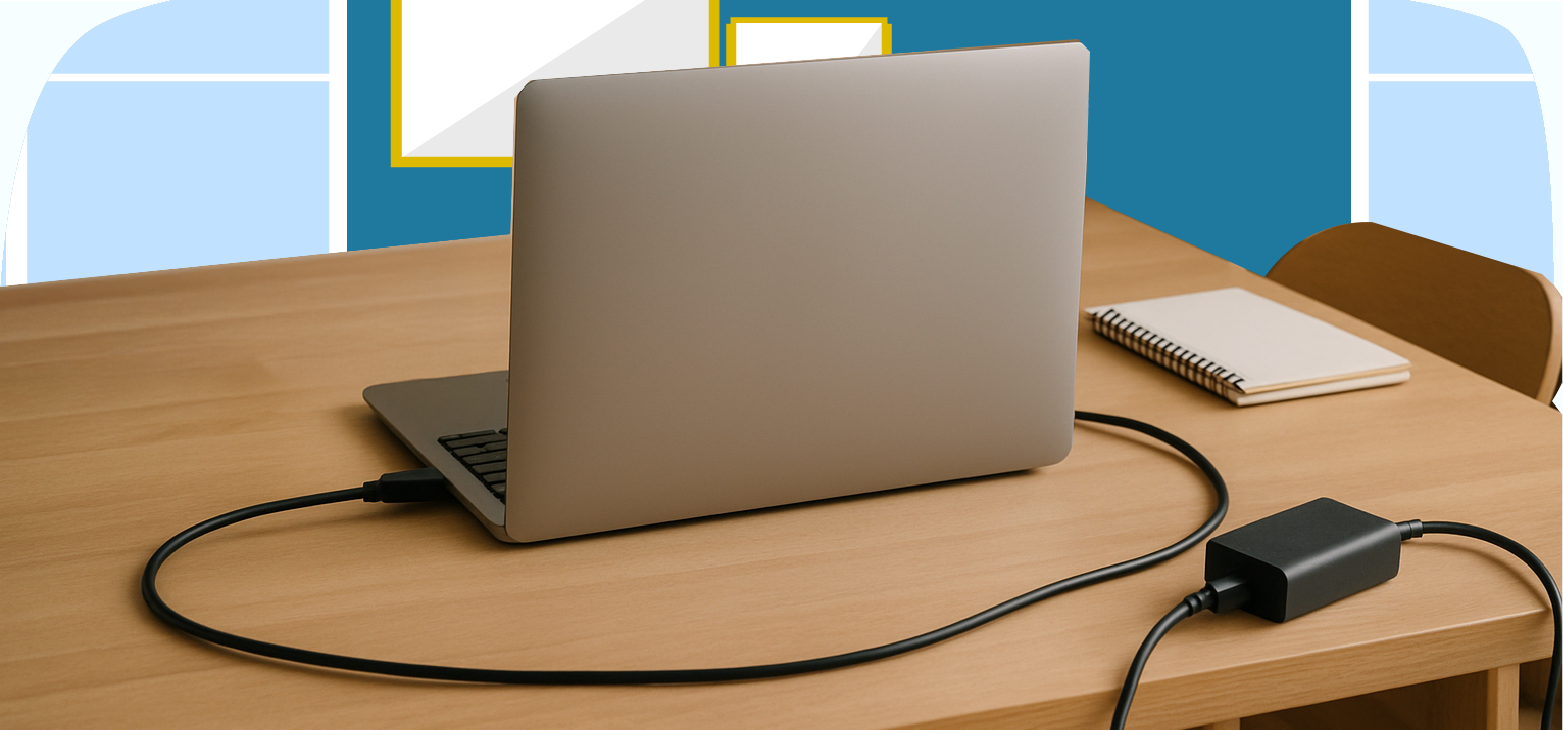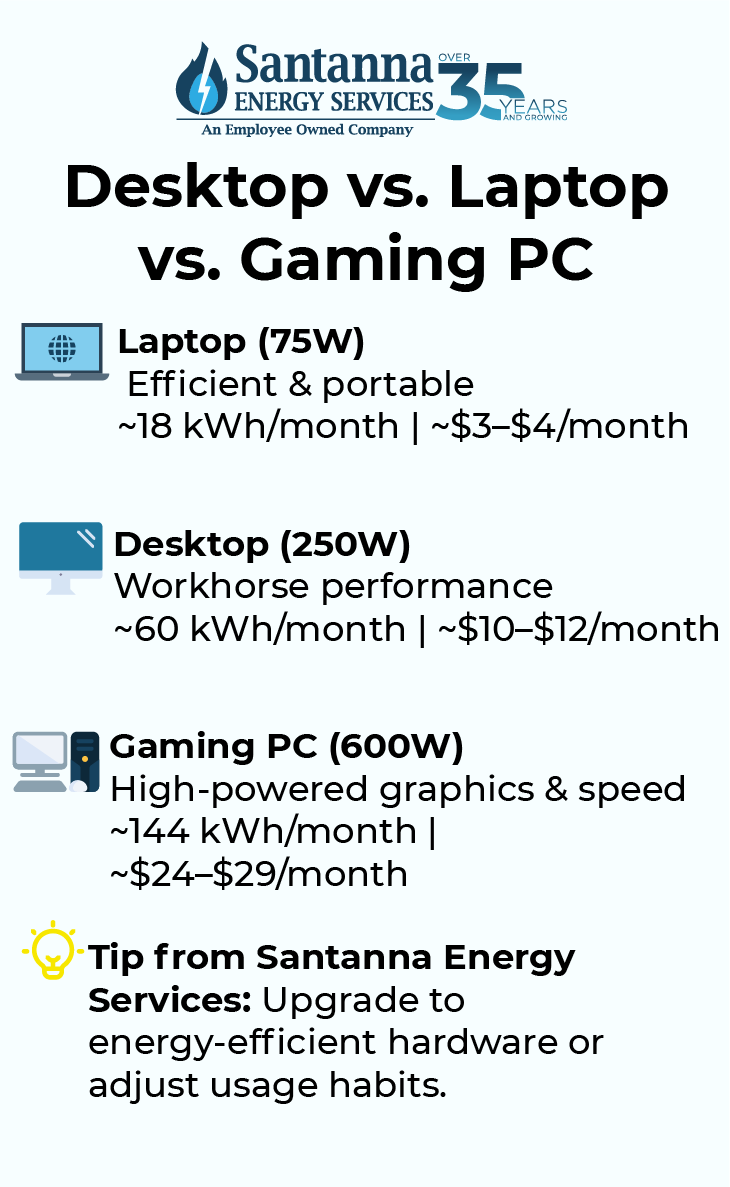How Much Electricity Does a Computer Use?
by Tyler Castle
21.7 min read

If you work from home, attend virtual classes, or spend hours gaming or streaming, your computer may be using more electricity than you think. While a single device might not seem like a big deal, the hours add up—especially when your PC is always on, paired with extra monitors, or left running in sleep mode.
Understanding how much electricity your computer consumes is a smart first step toward managing your home energy use. Whether you're trying to lower your bill, reduce your carbon footprint, or just stay ahead of surprise costs, knowing the numbers helps you stay in control.
Let's dive in and explore how much electricity your computer really uses and what you can do about it.
Key Points of This Article:
- Laptops are the most energy-efficient (50–100W), desktops use more (200–300W), and gaming PCs consume the most (500–700W). A gaming PC can use up to 144 kWh per month, about 16% of a typical household’s monthly electricity use.
- The longer and more intensively you use your computer, especially for gaming, video editing, or leaving it on 24/7, the more electricity it consumes.
- At the national average rate of $0.1745/kWh, running a laptop costs about $3/month, a desktop $10/month, and a gaming PC over $25/month.
- Use power-saving settings, unplug unused devices, and consider ENERGY STAR®-certified equipment. Sleep and hibernate modes significantly reduce power draw compared to leaving a computer fully on.
- Monitors, speakers, and other peripherals can quietly increase your energy use, especially if left on or in standby mode.
Do Computers Use a Lot of Electricity?
Compared to other appliances in your home, computers don’t use that much electricity by default. But they can use a lot of electricity if used heavily.
If you’re using your computer for long hours, have high-powered parts (like in a gaming PC), or tend to leave it running all the time, it can become one of the biggest energy users in your home, just after things like heating, cooling, and large appliances.
That means a gaming rig running for just 5 hours a day can use 3 kWh daily, close to what a dishwasher or window AC unit might use in the same period.
So, while a computer may not seem like a big energy drain on its own, how long you use it and what kind you have makes all the difference.
We’ve consulted our Santanna electricity experts, and here’s how the electricity consumption of your computer compares to other appliances in your home:
Electricity Consumption of a Computer Compared to Other Appliances in Your Home
| Appliance | Average Wattage (W) |
| Computer (Desktop) | 300 |
| Television (LED, 54.4-inch – 57.5 inch) | 100 |
| Refrigerator | 500 |
| Microwave | 1,000 |
| Dishwasher | 1,200 |
| Central Air Conditioner | 3,000 |
| Space Heater | 1,500 |
Do Gaming Computers Use a Lot of Electricity?
Gaming computers use a lot of electricity, especially when compared to standard desktops or laptops. Built for performance, gaming PCs often feature high-wattage components, advanced cooling systems, and multiple high-resolution monitors—all of which contribute to significantly higher power draw.
Gaming computers are optimized for fast frame rates, immersive graphics, and multitasking—all of which require powerful hardware. Here are a few things that can really drive up how much electricity a gaming computer uses:
- Graphics processing units (GPUs). The single most energy-intensive component in a gaming rig.
- Flagship processors that consume 125–200 watts, especially under gaming stress.
- Multiple monitors. Each monitor can add 25–80 watts, particularly if they’re large, curved, or high-refresh-rate (144Hz+). Monitors with the ENERGY STAR label typically use about 7% less energy than regular models on average.
- RGB lighting + cooling fans. Aesthetic lighting setups and powerful cooling systems can add 1-15 watts to total usage, especially in overclocked systems.
With all this considered, a high-end gaming setup with a powerful GPU, top-tier CPU, two large monitors, and RGB lighting could use up to 162 kWh per month, costing approximately $28.27 at an electricity rate of 17.45¢ per kWh. This would cost more than 3× the usage of a standard desktop.
How Many Watts Does a Computer Use?
It’s easy to overlook how much electricity your computer uses, especially when it’s not as loud or obvious as your microwave or air conditioner. But when you look at the numbers, you’ll see that a computer—especially a high-powered desktop or gaming PC—can draw as much power as many everyday household appliances.
Whether you’re working, studying, or gaming for hours each day, your system’s energy use can quietly climb. And when left running for long stretches, it may use more electricity than your TV, fridge, or even a space heater.
Knowing how many watts your computer uses is the first step to understanding how much electricity your computer consumes daily. And knowing how your computer stacks up against other appliances in your home gives you insight on where your energy dollars are going and where you might cut back to save on your electric bill.
We’ve found that a standard desktop computer uses around 300 watts. But a desktop can easily use as much power as a refrigerator if it’s used frequently enough. Even more so, a gaming PC could rival the energy consumption of a space heater if it is used heavily.
How Many Watts Do Different Computer Types Consume?
Your computer type plays a huge role in how much electricity your computer uses. From our research, it’s no surprise that laptops consume the least amount of electricity at 50-100 watts. As we’ve said before, desktops can consume anywhere from 200-300 watts, while large gaming computers consume 500-700 watts.
Average Power Usage by Computer Type
| Computer Type | Typical Wattage (Idle–Active) |
| Laptop | 50-100 watts |
| Desktop | 200-300 watts |
| Gaming PC | 500-700 watts |
These wattages reflect typical use across low activity (email, word processing) and high demand (gaming, video editing). But what does that mean for your actual electricity use?
Your daily usage varies widely based on both the type of computer and how intensively it’s used. The more time you spend on high-performance tasks like gaming, video editing, or 3D rendering, the more power your computer will consume—sometimes several kilowatt-hours per day.
So, while wattage gives you a snapshot, it’s your daily habits—how long and how intensely you use the device—that turn that number into a real impact on your energy bill.
How Much Electricity Does a Computer Use?
Now that you know the standard wattage of a computer, let's put this information into perspective and calculate how much electricity it uses. We'll convert our estimates into kilowatts hours as this is the most common unit of measurement used to calculate electricity consumption.
Let's assume you use your computer for 8 hours per day, which is common for remote workers and students. At this rate, here's how much electricity your computer uses per month, week, and year:
Daily, Weekly, Monthly, Annual Electricity Use of a Computer (kWh)
| Computer Type | Avg. Wattage Used* | Weekly kWh | Monthly kWh | Annual kWh |
| Laptop | 75W | 4.2 kWh | 18 kWh | 219 kWh |
| Desktop | 250W | 14 kWh | 60 kWh | 730 kWh |
| Gaming PC | 600W | 33.6 kWh | 144 kWh | 1,752 kWh |
* Note: These average wattages are calculated from the typical usage ranges listed above, reflecting a midpoint between idle and high-performance operation.
In a nutshell, a laptop uses around 18 kWh per month, a desktop uses 60 kWh, and a gaming PC can consume 144 kWh monthly or over 1,700 kWh per year—more than a TV or window AC unit in many homes.
To bring it home to you, the consumer, according to the U.S. Energy Information Administration, the average U.S. home uses about 899 kWh of electricity each month. If your usage is close to that, a laptop that uses 18 kWh per month would make up around 2% of your total energy use.
But the biggest draw? If you’re running a gaming PC that uses 144 kWh per month, that one device could account for a whopping 16% of your monthly electricity bill – that’s nearly a quarter! Factor in a high-performance monitor, screen brightness turned all the way up, and long gaming sessions, and suddenly your PC setup becomes one of the biggest energy hogs in your home, potentially blowing your utility budget on just a single device.

How Much Electricity Does a Computer Use in 24 Hours?
If you leave your computer running all day—whether for overnight downloads, long rendering tasks, server-like functions, or simply out of habit—the energy use adds up quickly. While most users don’t run their computers 24/7, many do leave them on for extended hours, especially in remote work or gaming households.
Here’s a look at how much electricity each computer type uses in 24 hours, based on average wattages:
How Much Electricity a Computer Uses in 24 Hours
| Computer Type | Average Wattage | 24-Hour Usage (kWh) |
| Laptop | 75W | 1.8 kWh |
| Desktop | 250W | 6 kWh |
| Gaming PC | 600W | 14.4 kWh |
Note: These wattages are averages derived from typical usage ranges, assuming moderate to active use across a full 24-hour period.
If you leave your computer running 24/7 along with downloads, gaming, remote access, this can easily triple your electricity usage.
Take a gaming PC as an example. Running this model of computer for 8 hours a day uses about 14.4 kWh a month costing you $0.08 per day at the national average of 17.45 cents per KWH as of April 2025. Couple that with a monitor 20–24″ adding 5–7 kWh to your daily usage and high brightness, this can raise your cost to $0.10–$0.12 per day, or roughly $3–$4 per month just for your gaming setup.
Energy Consumption of Different Computer Brands
Even the brand and model of your computer can significantly impact your energy consumption—and ultimately, your monthly electricity bill.
At Santanna Energy Services, we know that every detail matters when it comes to energy efficiency, which is why we analyzed power usage across some of the most popular computer brands and models on the market today. Here's how much electricity some of the most popular computer brands consume:
Energy Consumption of Different Computer Models Per Hour, Day, Week, and Month (for 8 Hours a Day)
| Computer Type | Energy Consumption Per Hour | Per Day (8 hrs) | Per Week | Per Month |
| MacBook Pro Laptop (72.4 W) | 0.072 kWh | 0.57 kWh | 4.05 kWh | 17.37 kWh |
| Dell XPS Laptop (110 W) | 0.11 kWh | 0.88 kWh | 6.16 kWh | 26.4 kWh |
| Lenovo ThinkPad laptop (170 W) | 0.17 kWh | 1.36 kWh | 9.52 kWh | 40.8 kWh |
| Microsoft Surface (65 W) | 0.065 kWh | 0.52 kWh | 3.64 kWh | 15.6 kWh |
| NVIDIA GeForce RTX 5080 Gaming PC (575 W) | 0.575 kWh | 4.6 kWh | 32.2 kWh | 138.0 kWh |
We highlighted just how much electricity different computer models consume when used for 8 hours a day, and the differences are striking across computer brands.
At the lower end, the Microsoft Surface, with its energy-efficient design, uses only 0.52 kWh per day or about 15.6 kWh per month, making it one of the most power-conscious options. Similarly, the MacBook Pro and Dell XPS laptops consume modest amounts—17.37 kWh and 26.4 kWh per month, respectively.
But as you cross into the computer models equipped for gaming, the consumption significantly rises.
The Lenovo ThinkPad, drawing 170 watts, consumes 40.8 kWh per month, nearly triple that of the Surface. At the top of the chart is the NVIDIA GeForce RTX 5080 gaming PC, a high-performance machine designed for graphics-intensive workloads, using a hefty 4.6 kWh daily—adding up to 138 kWh each month. That’s over eight times more than the Surface, clearly showing how your choice of computer can significantly impact your electricity bill.
How Much Does It Cost to Power a Computer?
The cost to power your computer depends on three main things: how much power it uses, how long it’s on each day, and your electricity rate.
To keep this realistic, we’ll use the national average electricity rate of $0.1745 per kWh (U.S. Energy Information Administration, April 2025) and assume 8 hours of usage per day, typical for remote workers, students, and gamers.
Average Cost to Power Different Computer Types
| Computer Type | Avg. Wattage | Daily Cost | Weekly Cost | Monthly Cost | Annual Cost |
| Laptop | 75W | $ 0.10 | $ 0.73 | $ 3.14 | $ 38.22 |
| Desktop | 250W | $ 0.35 | $ 2.44 | $ 10.47 | $ 127.39 |
| Gaming PC | 600W | $ 0.84 | $ 5.87 | $ 25.13 | $ 305.72 |
Based on this data, a laptop is the most energy-efficient, costing only about $3 per month or $38 per year to run. A desktop uses more power than a standard laptop and will cost you around $10 per month or $127 annually.
A gaming PC, with its high-performance parts, can cost nearly $25 a month or over $300 per year to operate. If your computer use tends to spike—like during long workdays, gaming sessions, or project deadlines— an Unlimited Electricity plan can offer more control and fewer surprises with no fluctuations in the supply charge of your bill!*
Costs to Run a Computer in Different U.S. States in the Midwest*
Understanding how much electricity your computer uses isn’t just about saving energy—it’s about managing your monthly utility bills more effectively, especially in states where electricity rates are rising.
According to the U.S. Energy Information Administration (EIA), the average cost of electricity varies significantly across the Midwest. That’s why it’s important to evaluate the daily operating cost of your devices based on where you live.
At Santanna Energy Services, we’ve helped thousands of customers across the Midwest make smarter energy choices. One of the best ways to do so is to optimize and keep an eye on the electricity consumption of your appliances.
Below is a breakdown of average daily electricity costs by state for each computer type. Whether you’re working remotely, gaming, or just browsing, this guide can help you understand how your tech habits impact your power bill:
Daily Cost to Run a Computer by State (Midwest Region)
| Type of Computer | Pennsylvania (18.98¢/kWh) | Illinois (18.32¢/kWh) | Indiana (17.01¢/kWh) | Michigan (19.95¢/kWh) | Ohio (16.34¢/kWh) |
| Laptop at 75W running for 8 hours | $0.11 | $0.11 | $0.10 | $0.12 | $0.10 |
| Desktop at 250W running for 8 hours | $0.38 | $0.37 | $0.34 | $0.40 | $0.33 |
| Gaming PC at 600W running for 8 hours | $0.91 | $0.88 | $0.82 | $0.96 | $0.78 |
*Costs are based on EIA estimation of average kWh as of April 2025.
Is It Cheaper To Use a Laptop Than a Desktop?
It’s definitely cheaper to use a laptop than a desktop, and the reason comes down to how much power each one uses.
Laptops are built to be efficient because they run on batteries. They use fewer watts, generate less heat, and often have smaller screens—all of which help reduce electricity consumption. A standard laptop uses around 75 watts, while a typical desktop draws about 250 watts during regular use.
Let’s break that down using the national average electricity rate of $0.1745/kWh and assuming 8 hours of use per day:
- A laptop uses 0.6 kWh/day = $0.10/day, or about $3.00/month
- A desktop uses 2.0 kWh/day = $0.35/day, or about $10.50/month
That means a desktop can cost more than 3x as much to run as a laptop over time. In a year, the difference can be over $90—especially if you use your computer daily for work, school, or gaming.
If you’re looking to save on electricity and don’t need high-end performance, using a laptop is the more energy-efficient and budget-friendly option.
The Cost of Adding a Computer Monitor to Your Existing Computer
Adding a second monitor might seem like a small upgrade—but it can quietly increase your electricity bill over time. Most monitors draw between 20 and 60 watts, depending on size, brightness, and resolution. Larger 4K or ultra-wide displays can even use up to 100 watts, especially at higher brightness settings or refresh rates.
Let’s break down how much adding a monitor to your computer set will cost you. At 50 watts, running 8 hours a day, a monitor would cost you $0.07 per day, $2.09 per month, $25.48 per year.
If you’re working from home or gaming daily, that second screen could cost you $20–$50 more per year, depending on how efficient the monitor is and how many hours it’s used. And if you add a third monitor or a high-refresh-rate gaming display, those numbers climb even faster.
Factors That Affect Computer Electricity Usage
Not all computers draw the same amount of power, even if they’re used for the same number of hours. The amount of electricity your computer uses depends on a mix of hardware specs, software behavior, user habits, and environmental factors. Here’s a breakdown of what matters most when it comes to how much energy your computer consumes:
- What’s Inside the Computer Matters: Powerful parts like high-end processors and graphics cards (used in gaming or editing) draw more electricity. Older computers also tend to use more power than newer, energy-efficient models. The more high tech (or low tech) the higher you’ll pay.
- Bigger Screens = More Power: Large monitors or dual-screen setups use more energy—especially if they’re high-resolution (like 4K). The more monitors you add, the higher the consumption.
- How You Use It Changes Everything: Doing basic things like browsing or emailing uses less power. Gaming, video editing, or even Zoom meetings? That pushes your computer into high power mode.
- What’s Plugged In Adds Up: Extra gear like monitors, printers, external drives, and speakers all draw electricity—even when not in use. Accessories can add $5–$10 a month to your bill without you realizing it.
- Your Settings Control Your Spending: Computers come with power-saving settings. Turning on sleep mode or setting auto-sleep can cut energy use overnight. Using high brightness or keeping your computer on makes your device work harder.
- Apps Running in the Background: Your computer might be busy even when you’re not using it—auto-updates, cloud backups, or antivirus scans can keep it active adding to your electricity consumption.
- Room Temperature Plays a Role: If your computer is in a hot or dusty area, its fans work harder to stay cool—pulling more electricity.
Will Computers Raise an Electric Bill?
The short answer is yes—computers can raise your electric bill, especially if you use them for long periods each day or run high-powered systems like gaming PCs or workstations. When usage crosses the threshold, your computer use becomes a noticeable part of your bill when:
- You use your system more than 8 hours/day
- You leave it on 24/7, even when idle
- You run high-demand tasks like gaming, editing, or mining
- You connect multiple monitors, speakers, or charging docks
- You don’t shut down or unplug overnight
Computers can raise your electric bill—but only if you’re unaware of how much power they’re using and how to manage it. By combining smart energy habits with the right energy plan, you can enjoy no spikes in the supply charge of your bill.*
Does Leaving a Computer in Sleep Mode Save Electricity?
Sleep mode does save electricity, but it’s not as simple as “off means zero” and “on means full power.” Depending on how your computer is configured, it may still draw a surprising amount of energy even when you think it’s idle. Let’s break it down:
When it comes to saving energy, not all “off” states are created equal. Modern computers are designed with multiple power modes that balance convenience with electricity usage.
How Much Power is Still Being Used in Standby Mode?
Even when your computer is shut down, it may still draw electricity, what’s often called phantom load or standby power.
Even in sleep or standby mode, many computers still draw between 1 and 60 watts of power. This happens because most devices today rely on adapters that continue pulling small amounts of electricity from the outlet, even when not actively in use. Some components also stay partially powered so the system can quickly wake up when needed. For example, laser printers might stay slightly active to avoid long warm-up times.
The exact amount of power used while idle depends on how your computer manages its internal components. Older models were limited in what they could power down—usually just the hard drive. But modern machines, especially laptops, are built to be more energy-efficient and can shut off most parts when not in use.
If you want to cut back on electricity, it’s worth managing all the gear around your computer, not just the PC itself.
Our Recommendations on When to Sleep, Hibernate, or Shut Down Your Computer
Choosing the right power mode depends on how long you’ll be away from your computer. For short breaks under an hour, sleep mode is ideal—it uses minimal power and lets you resume work almost instantly. If you’re stepping away for a longer period (1 to 6 hours), hibernation is a better option. It saves your session to the hard drive and powers down most of the system, using close to zero electricity while allowing you to pick up where you left off.
When you’re done for the day, going to bed, or heading out, a full shut down is recommended to fully close programs and stop background activity. And if you’re leaving town or won’t be using your computer for several days, it’s best to shut down and unplug the device entirely—this eliminates standby power draw from both your computer and any attached peripherals, cutting phantom load costs altogether.
And while each mode helps reduce electricity use, they vary in how much energy they actually save. Let’s break it down with a hypothetical example using a desktop that typically uses 250 watts when active.
How Much Electricity Does Sleep, Hibernate, or Shut Down Mode on Your Computer Cost You?
| Power Mode | Typical Power Draw | Energy Use Over 8 Hours | Estimated Cost at $0.1745/kWh |
| Active (On) | 250W | 2.0 kWh | $0.35 |
| Sleep Mode | 5W | 0.04 kWh | $0.007 |
| Hibernate | 1W | 0.008 kWh | $0.0014 |
| Shut Down | 0.2W (if plugged in) | 0.0016 kWh | ~$0.0003 |
| Unplugged | 0W | 0 kWh | $0.00 |
So, What Should You Use and When?
- Sleep Mode is best for short breaks (under 1 hour). It uses low power and lets you get back to work instantly. Sleep mode saves about 98% compared to staying fully on.
- Hibernate is ideal for longer breaks (1 to 6 hours). It shuts down almost everything while saving your session and only uses just 1 watt—nearly as low as shut down.
- Shut Down is perfect for overnight or when you’re done for the day. It stops most background activity. Shutting down completely still draws a small amount of standby power if left plugged in.
- Unplug your system completely when traveling or not using it for days. This is the only way to cut power use to zero.
Over a month, switching from leaving your computer on 24/7 to using sleep or hibernate mode during off-hours could save you $5–$15 per device—or more in households with multiple systems. Small choices, big difference.
Tips for Reducing Electricity Consumption When Using a Computer
Whether you’re working from home, gaming late into the night, or managing multiple devices in a household, it’s easy for computer-related electricity use to pile up—especially if devices are left running or idle. Fortunately, there are several proven strategies that can significantly cut down on energy use without sacrificing performance or convenience.
- Use Energy-Efficient Settings and Power Plans: Switch your computer to “Power Saver” or “Balanced” mode, let the screen turn off after a few minutes, and have it go to sleep when you’re not using it. These simple settings can cut your energy use in half.
- Install Smart Plugs, Power Strips, or Timers: Smart plugs and timers automatically cut power when your computer or accessories aren’t in use—saving electricity without you having to think about it.
- Upgrade to ENERGY STAR®-Certified Equipment: When buying new gear, choose ENERGY STAR® monitors or efficient parts like SSDs and certified power supplies. They use less power and help reduce heat and noise too.
- Combine with Smart Home Efficiency Tools: Adding LED bulbs, smart thermostats, and small fans to your setup keeps your home office cooler and more efficient, which helps your computer use less energy.
- Practice Smart Daily Habits: Unplug chargers, turn off unused devices, dim your screen, and update your software. These small steps add up and can save you real money on your energy bill.
Want true peace of mind with your energy use? Pair these tips with Santanna’s Unlimited Energy plan to keep your supply charge predictable—no matter how much time you spend at your desk.* Whether you’re running a smart home or a gaming fortress, it’s the smart way to stay efficient and in control.
FAQs
What’s the best time to run a computer?
The best time to run a computer is during off-peak electricity hours, typically late evening or early morning, depending on your utility provider.
What size battery do you need to back up a computer?
It depends on your setup and how long you want backup power. A basic laptop and Wi-Fi router can run for hours on a 1–2 kWh battery. But a full desktop setup using 3,000W for 12 hours would require around 36 kWh. Always size a bit higher to account for energy loss.
Is it better to leave my computer on or turn it off when not in use?
Turn it off if you’re away for more than an hour. Sleep mode helps in short breaks, but full shutdown saves more energy long-term and reduces wear on components.
Does the type of processor in a computer affect how much electricity it uses?
Absolutely. High-performance processors consume more power than low-wattage or mobile processors (like Intel U-series or Apple M-series). Efficiency varies by generation and design.
Does a computer use electricity when turned off?
Yes, if it’s plugged in, most computers still draw 0.2–2 watts in “off” mode due to phantom load or “vampire power.” Unplugging or using a smart strip stops this completely.
Your computer may not seem like an energy guzzler, but over time, especially with long workdays, gaming sessions, or multiple devices in use—it can become a quiet but consistent driver of your electricity bill.
By understanding how much electricity your system uses, what factors drive that usage, and how to manage it efficiently, you’re already on the path to making smarter, more informed energy choices. Whether you’re a remote worker, gamer, student, or multitasking parent, knowing your consumption puts you in control.
And with the right electricity plan, you don’t have to stress about it. Explore Santanna’s Unlimited Energy Plan today and enjoy total peace of mind—no surprises, no overages, just reliable energy for everything you plug in.
* Restrictions apply. Enrollment based upon program eligibility. Customers using more than 125% of normal monthly usage as determined by Santanna may be required to switch plans.
Tyler is an experienced energy professional, having worked for Santanna Energy Services, for the past four years. He is passionate about renewable energy and believes that diversifying the energy grid is the key to a sustainable future. Tyler is dedicated to supplying consumers with the best possible energy solutions and works diligently to make sure that Santanna can deliver the highest quality service.







